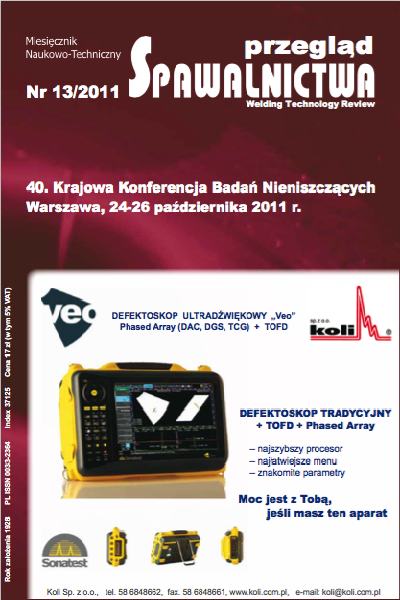Badanie kolejowych osi drążonych
Main Article Content
Abstract
W artykule przedstawiono metodę badania osi drążonych opracowaną przez firmę ULTRA. Konstrukcja tego typu osi narzuca podstawową metodę badania za pomocą głowicy 45 stopni umieszczonej wewnątrz otworu i przesuwanej wzdłuż osi. W tym rozwiązaniu oś jest badana jednocześnie dwoma głowicami zamocowanymi na dyszlu, który jest obracany i przesuwany wzdłuż osi. W trakcie badania przez cały czas jest identyfikowane położenie głowic (liniowe wzdłuż osi oraz kątowe na przekroju osi), co umożliwia precyzyjne określenie położenia ewentualnych wskazań, które są automatycznie rejestrowane. Położenie liniowe jest mierzone przez dodatkową głowicę ultradźwiękową, natomiast położenie kątowe za pomocą inklinometru. W wyniku badania uzyskuje się mapę wskazań oraz mapę miejsc niezbadanych.
Examination of drilled railway axles
Abstract
The examination method of drilled axles elaborated by ULTRA company is presented in the article. The construction of such axles imposes the basic method of examination the 45 degree probes moved inside drilled hole. In presented solution, the axle is tested simultaneously with two probes fixed o the thrill that is rotated and moved along axle. All the time during examination the location of probes is monitored (linear along the axle and angular on axle section). It enables the precise location of indications that are automatically registered. The linear location is measured with extra ultrasonic probes, the angular location with inclinometer. The result of examination is the map of indications and not tested places.
Downloads
Article Details
Creative Commons CC BY 4.0 https://creativecommons.org/licenses/by/4.0/
Welding Technology Review (WTR) articles are published open access under a CC BY licence (Creative Commons Attribution 4.0 International licence). The CC BY licence is the most open licence available and considered the industry 'gold standard' for open access; it is also preferred by many funders. This licence allows readers to copy and redistribute the material in any medium or format, and to alter, transform, or build upon the material, including for commercial use, providing the original author is credited.
